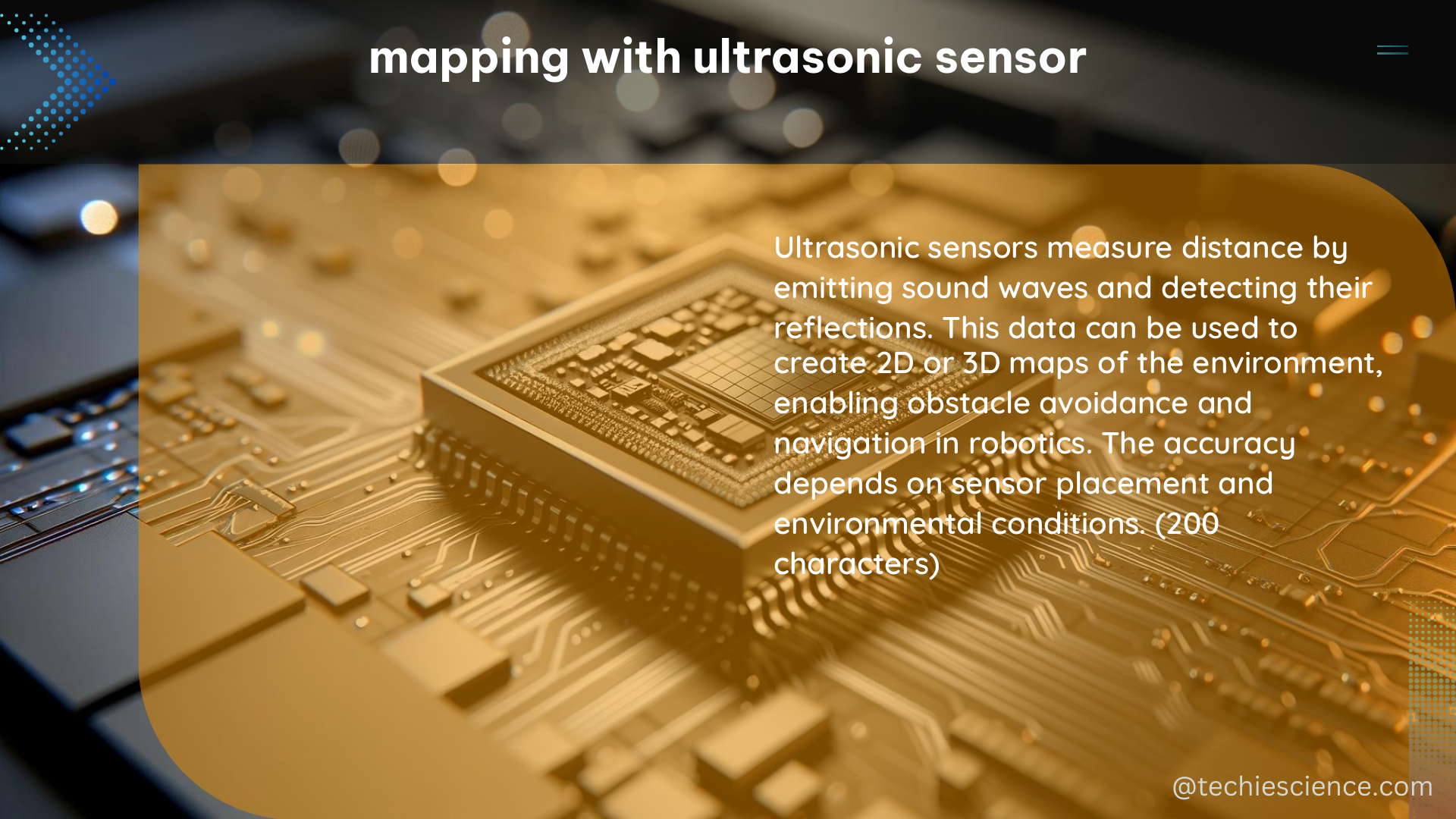Mapping with ultrasonic sensors is a powerful technique that utilizes sound waves to measure distances and detect objects in a specific area. This technology has a wide range of applications, including robotics, automation, and transportation systems. In this comprehensive guide, we will delve into the technical specifications of ultrasonic sensors, explore the various mapping techniques, and provide a step-by-step DIY guide to create your own mapping system.
Technical Specifications of Ultrasonic Sensors
Ultrasonic sensors are designed to operate within a specific frequency range, measurement range, angular field of view, response time, and temperature range. Understanding these technical specifications is crucial for selecting the right sensor for your mapping application.
Frequency Range
Ultrasonic sensors typically operate at frequencies between 20 kHz and several hundred kHz, with the most common frequency used in distance measurement being 40 kHz. This frequency range is chosen to ensure efficient sound wave propagation and minimize interference with other electronic devices.
Measurement Range
The measurement range of ultrasonic sensors varies depending on the model. For example, the popular HC-SR04 ultrasonic sensor has a measurement range of 2 cm to 400 cm, with an accuracy of ±3 mm. Other sensors may have different measurement ranges, such as the SRF05 with a range of 3 cm to 500 cm, or the MaxSonar-EZ4 with a range of 0 cm to 645 cm.
Angular Field of View
The angular field of view of ultrasonic sensors is typically between 15° and 30°. This determines the area that the sensor can effectively cover and is an important factor in the sensor placement and mapping strategy.
Response Time
The response time of ultrasonic sensors is usually between 10 ms and 100 ms, depending on the specific model. This parameter is crucial for applications that require fast object detection and distance measurement.
Temperature Range
Ultrasonic sensors are designed to operate in a wide temperature range, typically between -40°C and +85°C. This allows them to be used in a variety of environments, from outdoor applications to industrial settings.
Mapping with Ultrasonic Sensors

Mapping with ultrasonic sensors involves using the sensors to measure distances to objects in a specific area and creating a map of the environment. This can be achieved using two main techniques: time-of-flight measurements and triangulation.
Time-of-Flight Measurements
Time-of-flight measurements involve sending a sound wave from the sensor and measuring the time it takes for the wave to bounce back and return to the sensor. By knowing the speed of sound, the distance to the object can be calculated using the formula:
distance = (speed of sound × time) / 2
The speed of sound in air at 20°C is approximately 343 m/s, but this value can vary depending on the temperature and humidity of the environment.
Triangulation
Triangulation involves using multiple sensors to measure the distance to an object from different angles. By knowing the position of the sensors and the distance to the object, the position of the object can be calculated using trigonometry. This technique allows for more accurate mapping of the environment, as it can provide information about the shape and orientation of objects.
DIY Guide to Mapping with Ultrasonic Sensors
To create a DIY mapping system using ultrasonic sensors, you will need the following materials:
- Ultrasonic sensors (e.g., HC-SR04, SRF05, MaxSonar-EZ4)
- Microcontroller (e.g., Arduino, Raspberry Pi)
- Power supply
- Breadboard and jumper wires
- LCD display (optional)
Here are the steps to create a DIY mapping system using ultrasonic sensors:
-
Connect the Ultrasonic Sensors: Connect the ultrasonic sensors to the microcontroller according to the manufacturer’s instructions. This typically involves connecting the VCC, GND, Trigger, and Echo pins of the sensor to the appropriate pins on the microcontroller.
-
Write the Mapping Program: Develop a program that reads the distance measurements from the ultrasonic sensors and processes the data to create a map of the environment. This can be done using a programming language such as C++ or Python, depending on the microcontroller you are using.
-
For time-of-flight measurements, the program should calculate the distance to each object using the formula mentioned earlier.
-
For triangulation, the program should use the distance measurements from multiple sensors to calculate the position of each object.
-
Display the Mapping Data: (Optional) You can add an LCD display to the system to visualize the mapping data. The program should be able to display the distance measurements and the resulting map on the LCD.
-
Move the Sensors and Record Measurements: Move the ultrasonic sensors around the environment and record the distance measurements at various locations. This data will be used to create the final map.
-
Create the Map: Use the recorded distance measurements to create a map of the environment. This can be done using a mapping software or a spreadsheet program, where you can plot the position of the objects based on the sensor data.
By following this DIY guide, you can create a customized mapping system using ultrasonic sensors that can be tailored to your specific needs and applications.
References
- CONTROL VALVE HANDBOOK | Emerson: https://www.emerson.com/documents/automation/control-valve-handbook-en-3661206.pdf
- Intelligent Systems Using Sensors and/or Machine Learning to Detect Large Animal Movements: https://www.mdpi.com/1424-8220/22/7/2478
- An overview of monitoring methods for assessing the performance of…: https://www.sciencedirect.com/science/article/pii/S0012825221001033
- NUREG-1959 “Intrusion Detection Systems and Subsystems: https://www.nrc.gov/docs/ML1111/ML11112A009.pdf
- FRA Office of Research, Development, and Technology: https://railroads.dot.gov/sites/fra.dot.gov/files/2021-12/2022_RDT_CurrentProjects.pdf

The lambdageeks.com Core SME Team is a group of experienced subject matter experts from diverse scientific and technical fields including Physics, Chemistry, Technology,Electronics & Electrical Engineering, Automotive, Mechanical Engineering. Our team collaborates to create high-quality, well-researched articles on a wide range of science and technology topics for the lambdageeks.com website.
All Our Senior SME are having more than 7 Years of experience in the respective fields . They are either Working Industry Professionals or assocaited With different Universities. Refer Our Authors Page to get to know About our Core SMEs.